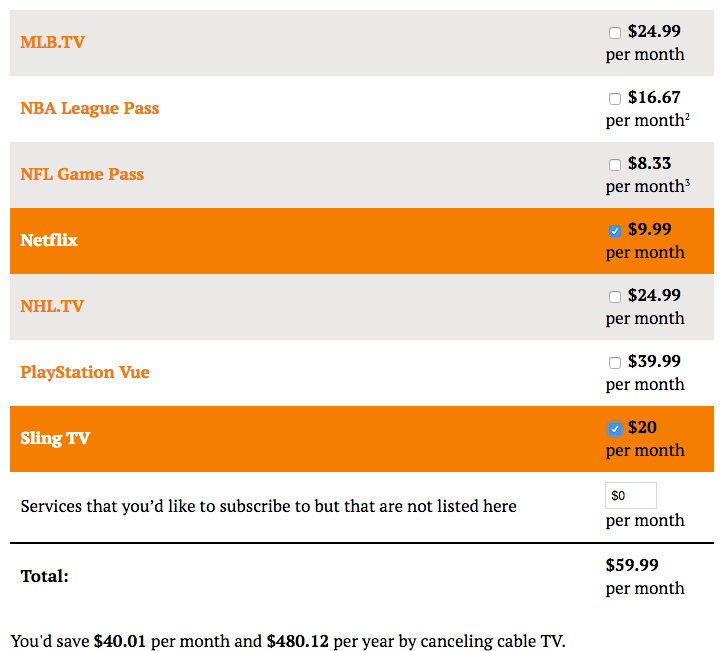Here's How Much You Can Save by Cutting the Cord

By:
After years of decline, cable television hit another low watermark this year.
Nielsen reported this summer that the first quarter of 2016 marked the first time that streaming video services occupied 50 percent of TV households in the US. While cable operators are still set up to reap major profits from the booming broadband industry, the numbers prove that people, especially millennials, are increasingly relying on alternatives to cable.
Research firm SNL Kagan forecasts that cable TV revenue could drop by $2.7 billion in the next decade, Variety reported:
Total residential video revenue for Comcast, Charter Communications and other American cable operators is projected to fall from $57.7 billion in 2016 to $55.0 billion annually in 2026, declining at a compound annual growth rate of 0.5% over the next 10 years, according to SNL Kagan. That’s as basic video subscriptions are projected to drop from about 53 million today to 45.4 million by 2026.
This reason is simple. For most people, cutting the cord is a huge cost-saver.
Cordcutting.com has a useful "cord cutting calculator" aimed at showing how much people can save by ditching pay TV for online video services. The tool asks users to plug in how much they pay currently pay for monthly cable and internet services, and to select streaming services they're considering.
 CordCutting.com - cordcutting.com
CordCutting.com - cordcutting.com
For example: Let's say you pay $100 for cable and internet and would only pay $30 for Internet alone. If you bought a $9.99 Netflix subscription, a $20 subscription to Sling TV, and cut the cord, "You'd save $40.01 per month and $480.12 per year by canceling cable TV," according to the calculator.
Pro Tip: Get an HD Antenna.
You know what sucks? "Cutting the cord" and dumping your cable box only to realize your package of streaming subscriptions doesn't let you watch FOX, CBS, NBC and ABC, and other broadcast TV staples that still produce quality shows. The good news is that buying and outfitting your tube with a simple (and cheap) HD antenna will help you snag those networks and more (don't forget your local public broadcast channel) for free.
Can cable survive?
While a lot of evidence suggests US consumers are becoming less dependent on cable, that doesn't necessarily mean a clean break. In 2014, the Wall Street Journal analyzed Nielsen data and reported that "Over the past four years, the top 40 most widely distributed channels in 2010—household names like CNN, ESPN and USA—have lost an average of 3.2 million subscribers, or more than 3% of their distribution." The Journal emphasized that the declines weren't just caused by people cutting the cord; many viewers are "cord shaving."
A growing share of pay-TV customers are signing up for smaller, cheaper bundles of channels that cost anywhere from $10 to $50 a month and don’t include popular channels like TNT, USA, ESPN, CNN, Fox News, Disney Channel and Discovery Channel, the industry executives say.
“What we are seeing is some cord cutting and some cord shaving,” said Stephen Hasker, global president of Nielsen. “Consumer time and attention is shifting.”
A piece by The Economist contends lists a major factor that explains why people haven't gotten over their reliance on cable, simply put: "customers are still addicted to live TV." As the Economists notes, cable providers have invested upward of $20 billion on deals with major sports networks, giving them a stranglehold on some of America's most beloved programs. As a result, it's far more likely that consumers will continue shaving their cord, rather than making a clean cut.
